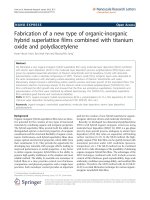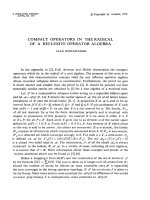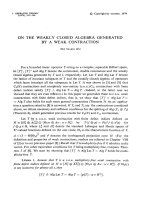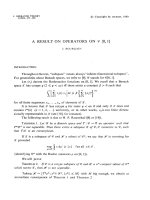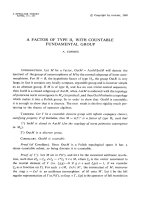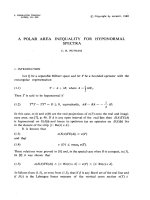Báo cáo toán học: "Aviezri Fraenkel: A Brief Biography" pptx
Bạn đang xem bản rút gọn của tài liệu. Xem và tải ngay bản đầy đủ của tài liệu tại đây (32.34 KB, 3 trang )
Aviezri Fraenkel: A Brief Biography
Shaula Fraenkel
Rehovot, Israel
Aviezri was born in 1929 in Munich, Germany, to Joel (Eugen) and Esther (Estella)
Fraenkel. Foreseeing dark clouds forming over Germany, the family—parents, two sisters,
and 3 year old Aviezri—left Germany. They lived in Basel, Switzerland, for a few years.
There Aviezri had his first two and a half years of schooling. In early 1939 the family
came to live in Jerusalem, Israel.
When Aviezri graduated from 8th grade in Horev elementary school, he decided he
had had his fill of schooling and teachers, and chose to acquire a profession. He became an
electrician’s apprentice, and eventually an electrician proper. After working three years
as an electrician, he realized he had mastered the trade and it didn’t challenge him any
more. So he decided to obtain higher education and study at the Technion, Israel Institute
of Technology, in Haifa. As he had never attended high school, he had to pass difficult
entrance exams to enter the Technion. In preparation for these exams he went to night
school for half a year, attended a yeshiva during the day, and in between volunteered and
trained in the Haganah underground in preparation for the day when the British Mandate
would expire and Jews would renew their own state in their ancient homeland.
Aviezri entered the Technion to study electrical engineering, but in his first year the
War of Independence broke out, the Technion closed its doors, and the students became
soldiers who had to defend their newborn state from enemy invasion and fight for our lives.
When the war ended, Aviezri continued his studies at the Technion, graduated, received
his electrical engineering diploma and B.Sc. degrees, then finished his army service as an
officer in the signal corps.
One day, he saw a newspaper advertisement addressed to engineers who might be
interested in participating in the design and construction of the first computer in Israel,
at the Weizmann Institute of Science. Aviezri decided to apply. During the job interview,
conducted at Weizmann in English, Aviezri was asked to design a multivibrator. Though
his English at the time was quite poor, he passed the “exam” with flying colors and was
accepted. Thus Aviezri became part of the original group that built the WEIZAC in
1953. The group was headed by Prof. Gerald Estrin from UCLA, who at the time was a
member of the group that had built the so-called JOHNNIAC, the prototype of the John
von-Neumann designed computers, constructed at IAS, Princeton. In-between he did his
M.Sc. degree.
In 1956 Aviezri married Shaula Babad. They resided in Rehovot and Aviezri worked
at the Weizmann Institute. In 1957 he was invited by Prof. Estrin to study at UCLA for
a Ph.D. in Computer Engineering. Aviezri was one of the first Israeli Fulbright students.
His eldest son Yedidya was born in Israel, and the young family moved, temporarily,
to Los Angeles. Three years of intensive studies led to the final doctoral exams, but
the electronic journal of combinatorics 8 (no. 2) (2001), #I1 1
there was an unpleasant surprise: the Engineering Department claimed that Aviezri’s two
favorite subjects of choice—Modern Algebra and Applied Math, in addition to Computer
Engineering—could not be considered as two distinct subjects for the Qualifying exams.
To the rescue came the late Prof. Ernst Straus, a former mathematical assistant of Albert
Einstein, and then Professor of Mathematics at UCLA. He told Aviezri that he could take
those three subjects for the Qualifying exams for a Ph.D. in Mathematics. The relieved
Aviezri came home and told his wife that she would get a mathematician husband, not an
engineer. Aviezri again passed his exam with flying colors, became a mathematician, and
has been one ever since. During the LA study period, two more sons were born, Yigal
and Amir.
Aviezri did his post-doctoral term in the Mathematics Department at the University
of Oregon, in Eugene. In 1962 the family returned home to Israel, and Aviezri started
working in the Mathematics Department of the Weizmann Institute of Science in Rehovot.
One week after our daughter Yael was born, Aviezri was sent to Minneapolis, Minnesota,
to supervise the final tests of a CDC mainframe computer purchased by Weizmann. He
chartered a cargo plane and brought the computer to the Weizmann Institute.
As a scientist, Aviezri is interested in, studies, creates and is involved in mathematics.
As a religious man, Aviezri is interested in, studies, creates and is involved in Jewish
knowledge and heritage. In 1962, during his stay in Minneapolis, while thinking and
discussing with a friend how computers could help to advance Judaic studies, Aviezri
conceived a very original idea based on information retrieval, which eventually became the
unique Responsa Project, known and used by the entire Jewish world. To explain: During
some 1700 years of exile (diaspora), Jews dispersed all over the world wrote questions to
the great leaders and rabbis of their time and received written responses. The questions
and responses, which are related to all walks of life, were written in many languages, in
different times and places. Thus they encompass an invaluable source of knowledge on
numerous areas of interest. Their main content is case-law. The number of surviving
responsa (many got lost) is estimated at half a million. However, for a long time they
were almost valueless because they were not arranged or written by subject, and any one
responsum may discuss many different issues and subjects. They are also written in many
languages, using unfamiliar abbreviations, etc. A person interested in specific information
was often not able to find what he needed in this ocean of knowledge.
Beginning in 1962, an attempt was made to compile by hand a man-made index, but it
proved to be an exponentially growing project, too inaccurate, and was finally abandoned.
Aviezri, on the other hand, had the unique and original idea of harnessing and utilizing
the new technology of computers for the benefit of Judaism and Jewish law. (By the way,
today judges, lawyers and secular jurists enjoy and utilize this method as well.) The idea
was to enter the full text of the Responsa into a computer, then ask the computer in a
clear and clever way for the needed information, and let the computer search for answers
and fish them out of the vast ocean of information.
Aviezri foresaw the future. When he first approached people and institutions with his
idea and how to implement it they didn’t understand him and didn’t believe it possible.
Aviezri had to fight hard to acquire acceptance. Today the Responsa Project is known
the electronic journal of combinatorics 8 (no. 2) (2001), #I1 2
and used all over the Jewish world.
During all these years, Aviezri has been working as a mathematician in the Computer
Science and Applied Mathematics Department at the Weizmann Institute, and teaching
at Weizmann’s Feinberg graduate school. Six years ago he began, in addition, to write and
publish in Judaica, in Hebrew. After daughter Yael, two more sons were born: Avraham
and Yishai. Shortly after the birth of Yishai, who was our sixth child, we were visited by
Paul Erd˝os. He told us that 6 is a perfect number and that he thought we would never
make it to the next perfect number, which is 28.
Before the kids married, when they were all still at home, the entire family used to
hike all around the country, and also in other countries during sabbaticals. This tradition
passed on to the next generation. The children who now have children of their own, all
like to hike. Of course during all these years, like many good Israelis, Aviezri did his
reserve military service, and unfortunately had to take part in the many wars we had to
fight in order to defend our lives and our country. Like him, his sons and son-in-law serve
in the army and in the reserves. Yael did national service too.
Yedidya, the oldest, publishes old manuscripts and does research in Judaica. He holds
an M.Sc. in Library Sciences, specializes in manuscripts of the Vilna Gaon, and is working
on his Ph.D. in Talmud.
Yigal, who has a Ph.D. in chemistry, also studied patent law and combines the two in
his work as a patent attorney. He married Ita’el, who has an M.Sc. in physics and works
in software engineering as a senior program manager. They have five children.
Amir studied computer engineering. He works in computerized design and construc-
tion of moulds for materials, products and various applications. The main methodology
is electro-erosion.
Yael has a B.Ed. in mathematics and Jewish studies, and works as a project manager
at an electronic documentation company. She is married to David Klein, who has a
Ph.D. in Mathematics, and develops scientific software for financial markets. They have
five children.
Avraham is an attorney with the legal department at the national police headquarters
in Jerusalem. He is married to Rachel, who specializes in higher Judaic studies for women.
They have three children.
Yishai has a B.Sc. in mathematics and computer science and is now doing his M.Sc. in
management. Married to Merav, a physician of internal medicine at the Kaplan Hospital,
he is a software engineering manager at the INTEL networking design center in Jerusalem.
They have three children.
Shaula, Aviezri’s wife [Yael’s note: who made it all possible] is a high school teacher
and a translator from English to Hebrew. [Yael’s 2nd note: She also volunteers much of
her time teaching Jewish studies to adults, including new immigrants.]
the electronic journal of combinatorics 8 (no. 2) (2001), #I1 3
